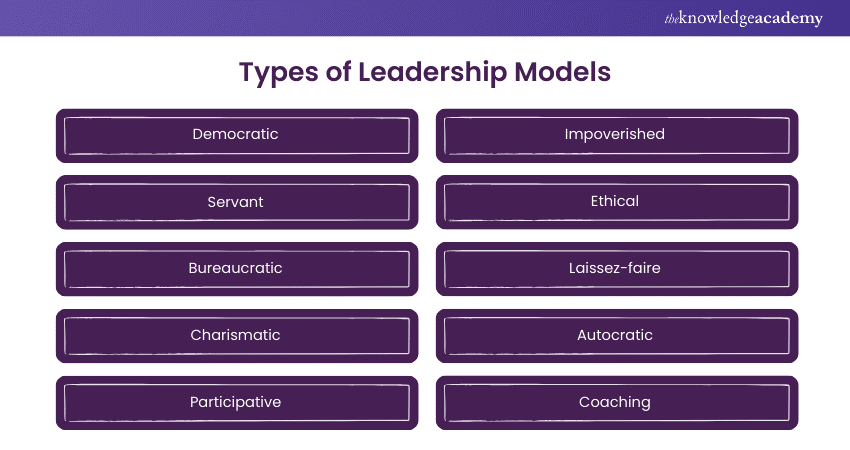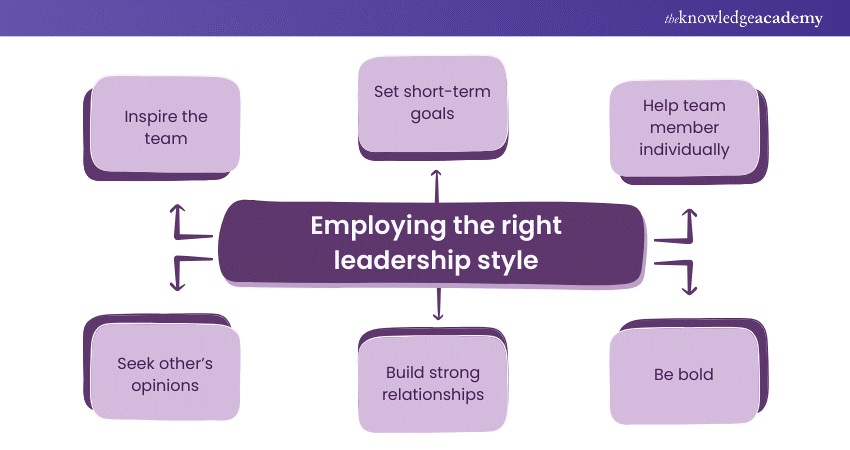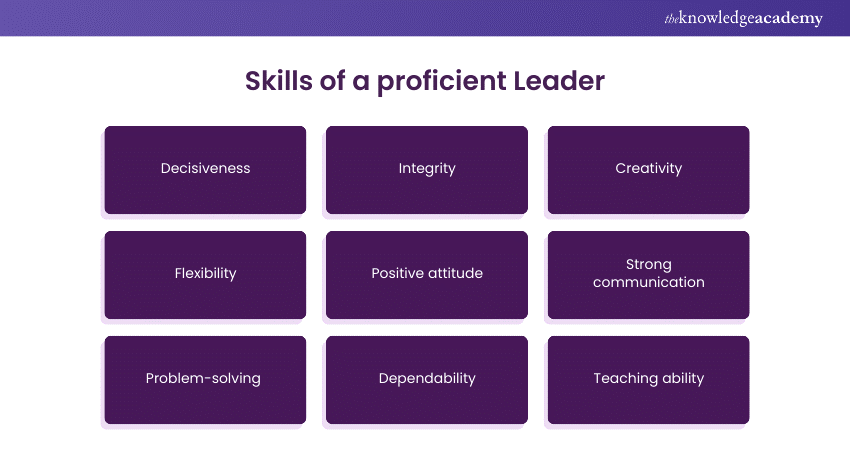We may not have the course you’re looking for. If you enquire or give us a call on 01344203999 and speak to our training experts, we may still be able to help with your training requirements.
Training Outcomes Within Your Budget!
We ensure quality, budget-alignment, and timely delivery by our expert instructors.

As an essential trait, Leadership drives organisations toward success. Over the years, numerous Leadership Models have evolved to drive enterprises towards success. Moreover, these Models come in various forms, empowering Managers to inspire and provide feedback to their team members effectively.
If you're curious about exploring the diverse landscape of Leadership Models, then this blog is for you. Let’s dive in!
Table of Contents
1) What are Leadership Models?
2) 10 types of Leadership Models
3) Employing the right Leadership style
4) Skills of a proficient Leader
5) Ways to improve Leadership skills
6) Conclusion
What are Leadership Models?
In simple terms, a Leadership Model is a set of practices and ideas explaining how to collaborate to accomplish a common goal. Leadership Models familiarise top executives or senior managers with effectively leading a team. Essentially, they portray how the tasks of decent-quality Leaders can considerably contribute toward a company’s objectives and achievements.
While Leadership Models are relevant to Leadership styles, they both are entirely separate conceptions. On the one hand, Models talk about conceptual structure besides explaining what makes a decent Leader. However, styles examine the Leadership behaviour patterns that can be exhibited by the Leaders of an organisation.
10 types of Leadership Models
Amidst the different types of Leadership Models, the discussed below ones holds a major relevance in today’s context. For a detailed overview, you can read over the following points:

1) Democratic
This Model helps team members work efficiently by including them in the decision-making processes. Essentially, it familiarises them with their aim inside an organisation. To become a democratic Leader, professionals must be motivating, self-governing, and inclusive.
2) Servant
Such Models require Leaders to concentrate on others’ major requirements and mentor them as and when required. Through mentoring, they can lift others to greater success and allow businesses to reach potential heights. This Model further ensures that Leaders can gain insight into both their work and life purposes.
3) Bureaucratic
The production field can find Bureaucratic Leadership Models to be extremely helpful. These can further help Leaders to effectively control the processes of working with mechanisms, which include safety regulations. Although they are essential Models, they might lack the ability to provide flexibility.
4) Charismatic
This aims to create enthusiasm for the team and achieve the company’s long-term goals through each member’s communicative and responsive behaviours. Nevertheless, it mandates a Leader to shape others’ values instead of just working beyond requirements. Charismatic Leaders should be good communicators, engaging, responsive to others, and so on.
5) Participative
This Leadership Model is specifically a combination of Leadership subcategories, each of which concentrates on productive communication, and feedback. Through this approach, Leaders can aim to unite the team and drive success to the organisation. Nevertheless, participative Leaders’ ability to seek feedback and encourage team participation in making effective decisions for the team distinguishes them from the rest.
6) Impoverished
As the least effective Leadership Model, it distances itself from motivation, teamwork, and outcomes. Nevertheless, the benefit of this style includes facilitating problem-solving between team members and letting employees work out their ideas. However, it can lead to a lack of accountability and incompetency among individuals and teams.
7) Ethical
Among the key Leadership Models include following ethics and providing employees with appropriate and fair rewards as well as criticisms. Most importantly, an ethical Leader must ensure that their decision is justified and logical instead of being emotional. This Model encourages a Leader to steadily contribute toward reaching a company’s objectives.
8) Laissez-faire
Before delving into its details, professionals must know that the execution of this Model comes with both advantages and disadvantages. This is because it helps employees decide and take up work on their own. But this unassertive Leadership Model can fail to motivate employees.
9) Autocratic
The Autocratic Leadership Model specifies that team members cannot have the opportunity to suggest anything related to work. Nevertheless, this doesn’t help professionals to efficiently lead creative jobs. Instead, it works well with regular jobs that don’t necessitate specific skills.
Moreover, autocratic Leaders can harm manager-worker relationships since they lack strong communication skills. The crucial attributes of these Leaders include being decisive, domineering, dictatorial, authoritative, and so on.
10) Coaching
Apart from the above-discussed Models, this approach allows professionals to figure out each team member’s strengths and come up with development tactics. This also talks about the tools to utilise to boost a company’s success. It guides Leaders to concentrate on the entire company’s success and achieve it in accordance with other coaching team members.
Enhance your Leadership abilities through our Leadership Skills Training today!
Employing the right Leadership style
Leadership styles can help senior professionals to drive toward a company’s long-term success and development. Thus, applying them in the right way can lead to major benefits. Here are the steps involved in employing the right Leadership style:

1) Inspire the team: Efficient Leaders should motivate other group members and treat them with empathy as well as understanding. They can also set a positive example to inspire the group.
2) Set short-term goals: To become an adequate Team Leader, professionals need to set several short-term objectives. In addition, they must ensure that each team member knows about their tasks and deadlines. For better results, they can discuss and provide constructive feedback to every team member.
3) Help team members individually: To demonstrate genuine concern for the personal development of every team member, Leaders should provide tailored assistance and support. In order to do this, they can conduct one-on-one meetings, examine their strengths, and offer recommendations for improvement.
4) Seek others’ opinions: Since Leadership is all about collaboration and combination, effective Leaders must ask each group individual to share their opinions. This primarily shows that everyone’s contributions matter. Nowadays, it can be done by asking them to fill out a Google Form either every week or month.
5) Build strong relationships: To apply affiliative Leadership Models, professionals should focus on creating and strengthening meaningful relationships with other team members. Although effective communication supports this strategy, team-building activities can be more advantageous in many ways.
6) Be bold: Coherent Leaders must be bold in how they lead a team. Apart from the success, they should encourage teams to learn from their past mistakes. This can further help team members to feel more confident in their abilities.
Join our Agile Leadership Training and become a proficient Leader. Sign up now!
Skills of a proficient Leader
For anyone willing to advance in their career, the list of Leadership skills can benefit them in multiple ways:

a) Decisiveness: This is an indispensable Leadership skill that helps professionals work on projects with improved efficiency. Nevertheless, efficient decisiveness calls for research, evaluation, problem-solving, and goal-setting.
b) Integrity: It simply means to have and stand by a set of strong values. Through this skill, Leaders help companies to make ethical choices and maintain a positive image. Besides, they should possess skills like ethics, diplomacy, professionalism, confidentiality, and so on.
c) Creativity: Decent Leaders often need to think outside the box to make insightful decisions. For this, they must be creative and foster effective collaboration and innovation in the workplace. Their creative skills should include critical thinking, innovation, collaboration, curiosity, open-mindedness, etc.
d) Flexibility: A potential Leader must be flexible enough to deal with last-minute changes or unexpected problems. Apart from these, they must be open to new suggestions and feedback. Being flexible, they should be open to negotiating, adapting, and handling work-life balance.
e) Positive attitude: An effective Leader needs to create a positive work environment, even during pressured situations. This competency further assists Team Leaders to keep other members motivated and productive. Specifically, they should promote a work environment that fosters conflict management, empathy, social skills, respect, and so on.
f) Strong communication: Enthusiastic Leaders should clearly explain things to their team. For this, they must possess excellent communication skills and further promote transparency and a comfortable work atmosphere. Additionally, they must possess active listening, written communication, public speaking, and presentation skills.
g) Problem-solving: Leadership roles often require keeping calm and figuring out a detailed solution procedure. Through these skills, Leaders can make quick decisions, resolve obstacles, and ensure that tasks are completed on time and as per the requirements.
h) Dependability: Essentially, senior managers should be dependable Leaders. Being dependable means that he/she can be trusted and relied on by others. In addition, they must meet tight deadlines and be straightforward while communicating.
i) Teaching ability: Another proficient skill that separates Leaders from other professionals is the capability to mentor other group members. This skill calls for Leaders to think about how teams can achieve success, instead of thinking less about themselves.
Boost your Leadership potential with our Ethical Leadership Training
Ways to improve Leadership skills
Developing Leadership qualities requires time and practice. Let's explore some useful tips to improve your Leadership skills:
a) Identify the Leadership style: It is mandatory to figure out the ways to lead a team, meetings, and projects. Most professionals boost their styles based on their company’s unique needs.
b) Figure out strengths and improvement areas: Leaders must patiently consider what qualities they have and which areas require improvement. Moreover, seeking professional feedback from trusted mentors can help with this.
c) Be patient: Turning into an effective Leader takes years or even decades. Hence, Leaders must have patience, allow themselves to make mistakes and learn over time.
Become an accomplished Leader with our Creative Leader Training. Join us today!
Conclusion
Budding Leaders must improve their comprehension of many Leadership philosophies. By grasping the numerous Leadership Models discussed here, they can modify their strategy for various scenarios and motivate their group members to accomplish common objectives.
Frequently Asked Questions

There are numerous Leadership Models, each offering unique insights and approaches to effective Leadership.

To become a well-organised and decent Leader, professionals must have five qualities such as strong communication, compelling vision, empathy, accountability, and learning agility.

The Knowledge Academy takes global learning to new heights, offering over 30,000 online courses across 490+ locations in 220 countries. This expansive reach ensures accessibility and convenience for learners worldwide.
Alongside our diverse Online Course Catalogue, encompassing 17 major categories, we go the extra mile by providing a plethora of free educational Online Resources like News updates, Blogs, videos, webinars, and interview questions. Tailoring learning experiences further, professionals can maximise value with customisable Course Bundles of TKA.

The Knowledge Academy’s Knowledge Pass, a prepaid voucher, adds another layer of flexibility, allowing course bookings over a 12-month period. Join us on a journey where education knows no bounds.

The Knowledge Academy offers various Leadership Courses, including Leadership skills Training, Agile Leadership Training and Creative Leader Training. These courses cater to different skill levels, providing comprehensive insights into People Management Skills.
Our Business Skills Blogs cover a range of topics related to Leadership, offering valuable resources, best practices, and industry insights. Whether you are a beginner or looking to advance your Business skills, The Knowledge Academy's diverse courses and informative blogs have you covered.
Upcoming Business Skills Resources Batches & Dates
Date
 Leadership Skills Training
Leadership Skills Training
Fri 31st May 2024
Fri 28th Jun 2024
Fri 26th Jul 2024
Fri 30th Aug 2024
Fri 27th Sep 2024
Fri 25th Oct 2024
Fri 29th Nov 2024
Fri 27th Dec 2024







 Top Rated Course
Top Rated Course



 If you wish to make any changes to your course, please
If you wish to make any changes to your course, please


